Overview of Pentax CM100 Single Phase Single-impeller Centrifugal Pump
The Pentax CM100 is a single-phase, single-impeller centrifugal pump renowned for its extreme quietness, making it suitable for a variety of applications including domestic, civil, and industrial settings. It features a flat performance curve to ensure constant pressure despite flow rate variations. The pump is constructed with a cast iron body and Noryl or brass impeller, with a ceramic-graphite-NBR seal.
It can handle a maximum ambient temperature of 0 – 50°C for the Noryl impeller and 0 – 90°C for the brass impeller, with a maximum pressure of 6 bar for models 45-100 and 8 bar for models 164-550. The Pentax pump CM100 model specifically offers a power output of 1 HP (0.74 kW), a flow rate of 20 – 90 l/min, and a manometric head of up to 32.5 meters.
You can review the specifications of Pentax CM100 Single Phase Single-impeller Centrifugal Pump on this page.
How does Pentax CM100 Single Phase Single-impeller Centrifugal Pump work?
The Pentax CM100 water pump operates on the principles of centrifugal force, which is the force that acts on objects moving in a circular path and is directed outward from the center of rotation. In the case of the CM100, when the pump’s motor activates, it spins the impeller, a disk with vanes attached to it, at high speeds. As the impeller rotates, it imparts kinetic energy to the water or fluid being pumped, causing the water to move radially outward from the pump’s inlet to its outlet. This movement of water creates an area of low pressure at the inlet, drawing more water into the pump, thus maintaining a continuous flow.
In the second stage of operation, as the water is expelled from the impeller, it enters the pump casing. This casing is specially designed to convert the kinetic energy of the water into pressure energy. As the water slows down in the expanding casing, the kinetic energy is converted into potential energy in the form of increased pressure. This pressurized water is then directed to the pump’s outlet and into the piping system for distribution. The CM100’s design ensures a flat performance curve, meaning it can maintain a constant pressure even as the flow rate varies, making it highly efficient for a variety of applications
Exclusive features and benefits of Pentax CM100 Single Phase Single-impeller Centrifugal Pump
The Pentax CM100 Single Phase Single-impeller Centrifugal Pump boasts several exclusive features and benefits that make it a standout choice for various applications. Here are some of its key advantages:
- Extremely Quiet Operation: The CM100 is designed to operate with minimal noise, making it ideal for environments where noise levels are a concern.
- High Flow, Low Pressure: It is capable of delivering a high flow rate while maintaining low pressure, perfect for clean water use without abrasives.
- Versatile Impeller Options: The pump comes with a choice of a technopolymer or brass impeller, with the brass option capable of handling up to 10mm soft solids.
- Robust Construction: With a cast iron pump body and carbon mechanical seal, the CM100 is built for durability and long service life.
- Temperature Adaptability: It can handle liquid peak temperatures of up to 50°C with the Noryl® impeller and up to 90°C with the brass impeller.
- Pressure Capability: The pump body gasket can withstand pressures of up to 6 bar for models 45-100 and up to 8 bar for models 164-550.
- Efficient Motor: The CM100 features a 2 poles induction motor with thermal protection up to MEC 80, ensuring efficient operation.
Pentax CM100 Single Phase Single-impeller Centrifugal Pump installation and usage
- Location: Install the pump in a dry, well-ventilated area with easy access for maintenance.
- Foundation: Securely mount the pump on a stable, level base to minimize vibration.
- Piping: Connect the inlet and outlet pipes ensuring they are properly aligned and supported to prevent strain on the pump casing.
- Electrical: Ensure the power supply matches the pump’s specifications (single phase). Properly ground the pump and connect the electrical wiring according to the wiring diagram.
- Priming: Fill the pump casing with water to prime it before starting.
- Operation: Start the pump and check for leaks, proper flow, and pressure. Adjust the valves as needed.
The Pentax CM100 Single Phase Single-impeller Centrifugal Pump is versatile and used in various applications, including:
- Residential Water Supply: Providing consistent water pressure for homes and small buildings.
- Irrigation Systems: Watering gardens, lawns, and small agricultural plots.
- Industrial Processes: Circulating water in cooling systems, washing systems, and other industrial processes.
- HVAC Systems: Assisting in the circulation of water in heating, ventilation, and air conditioning systems.
- Water Transfer: Moving water from one location to another, such as in rainwater harvesting systems.
- Booster Systems: Enhancing water pressure in pipelines for better distribution.
Pentax CM100 Single Phase Single-impeller Centrifugal Pump components
The Pentax CM100 Single Phase Single-impeller Centrifugal Pump is composed of several key components that work together to ensure its efficient operation. Here’s a breakdown of its main components:
- Pump Body: Made of cast iron, providing durability and stability to the pump structure.
- Motor Bracket: Also constructed of cast iron for models 45, 50, 164-550, and aluminum for models 75-100, it supports the motor and aligns it with the pump shaft.
- Impeller: Available in Noryl for model 45, Noryl or brass for models 50-314, and brass for models 400-550, the impeller is the rotating part that transfers energy to the fluid.
- Seal: A ceramic-graphite-NBR seal ensures a tight and leak-proof connection between the pump shaft and the motor bracket.
- Pump Shaft End: Made of AISI 416 steel for models 45-100 and AISI 303 steel for models 164-550, it connects the impeller to the motor.
- Ambient Temperature: The pump can operate within an ambient temperature range of 0 – 50°C for the Noryl impeller and 0 – 90°C for the brass impeller.
- Pump Body Gasket: Capable of withstanding a maximum pressure of 6 bar for models 45-100 and 8 bar for models 164-550.
- Motor: A 2 poles induction motor with thermal protection up to MEC 80, providing reliable power to the pump.
- Insulation Class: Class F insulation ensures the motor is protected against temperature fluctuations and electrical hazards.
- Protection Degree: The pump has an IPX4 protection degree, safeguarding it from water splashes from all directions.
Important tips for buying Pentax CM100 Single Phase Single-impeller Centrifugal Pump
- Check the Specifications
- Application Suitability
- Material Quality
- Motor Protection
- Insulation and Protection
- Non-Self-Priming
- Warranty and Support
- Price Comparison
You can check Pentax CM100 Single Phase Single-impeller Centrifugal Pump price and buy it on Famcocorp website.

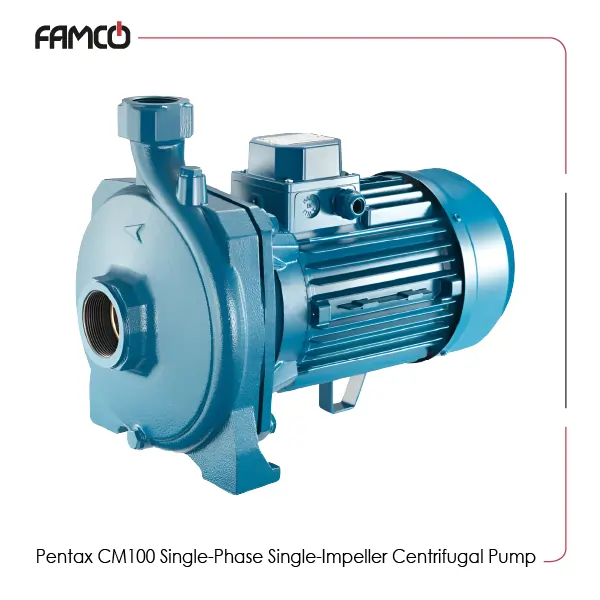



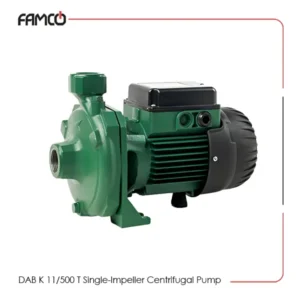
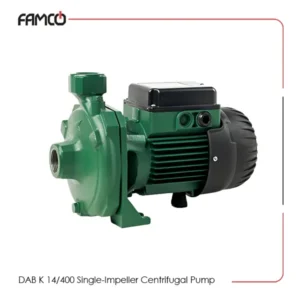
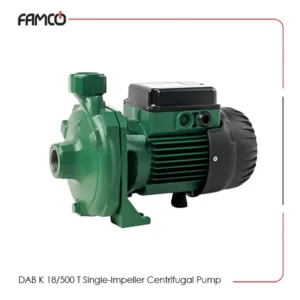
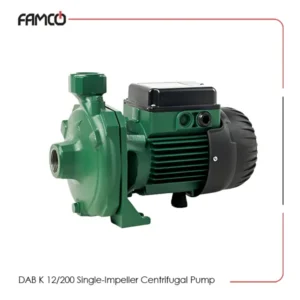

There are no reviews yet.